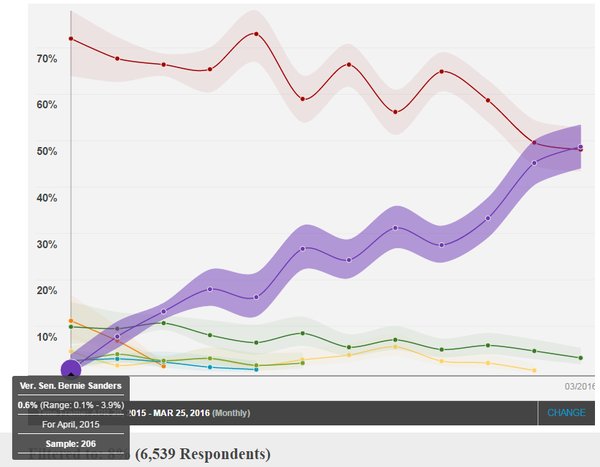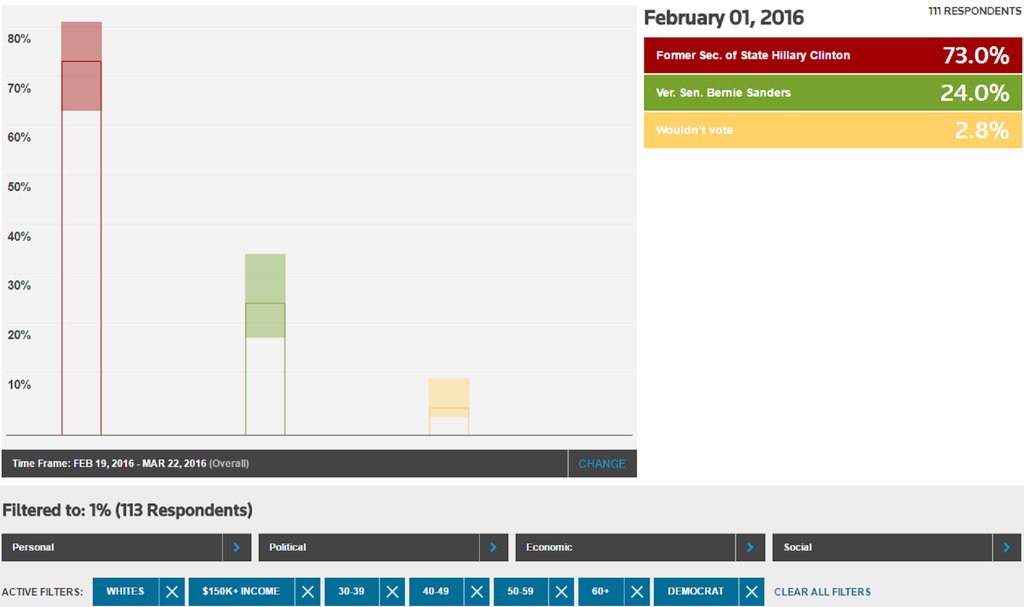Behind #BernieMadeMeWhite
The creator of the popular hashtag on how the media misrepresents Bernie's base.
If you’ve read anything about Bernie Sanders and black or minority voters, you’ve read about how he doesn’t, can’t, or won’t win them over. Countless articles describe the campaign as either tone deaf on race issues or, even worse, merely the left version of Donald Trump’s white-male grievance campaign. A corollary is the oft-repeated “Bernie Bros” narrative, which casts Sanders’s supporters as primarily young angry white men who are one anime avatar away from being in Gamer Gate.
But when it comes to Sanders’s allegedly melanin-poor supporters, there are more shallow opinions than hard facts. While Hillary Clinton won overwhelming majorities of black voters in states like South Carolina, Clinton’s margin of support among African Americans in the North has been smaller. With younger black voters, the Vermont senator has often tied or outpaced her.
And Sanders has now made up so much ground that he’s running neck-and-neck with Clinton among nonwhite registered Democrats younger than fifty.

Finding these voting blocs inconvenient to its preferred framing, the media has largely ignored them. Instead of articles about the young female, black, Hispanic, Native American, Asian American, and Arab Americans who back Sanders, we get a deluge of articles about the horrifying paleness of Sanders’s base.
We get absolute silence about Clinton’s especially strong backing from rich white Democrats over thirty.

Meanwhile, when Clinton’s abysmal numbers among young voters are even discussed, they’re often chalked up to youthful idealism — not to any flaw of Clinton as a candidate.
Last weekend, my frustration with this media phenomenon hit a new high.
Following Sanders’s landslide wins in Alaska, Hawaii, and Washington, the media rushed to fit the resounding victories into its preconceived framework. The Washington Post typified the reaction, publishing an article entitled “Why Did Bernie Sanders Dominate Saturday? Caucuses in Whiter States.” Hawaii is the least white state in the country, with more than three-quarters of its residents from nonwhite and mixed race backgrounds; Washington is one of the country’s ten most heterogeneous states.
Many who favor Sanders predicted that his anticipated victories in Hawaii, Alaska, and Washington would do nothing to change the narrative about Bernie’s POC “problem.” But such brazen whitewashing was too much.
I, along with tens of thousands of others, decided to express my vexation using the hashtag #BernieMadeMeWhite. “Ever since I voted for Bernie,” my first tweet read, “I’ve been binge watching Friends. #BernieMadeMeWhite.”
Within a few hours, the hashtag was the number one trending topic, beating out even #TheWalkingDead. I wasn’t surprised at its resonance. The media, armed with a facile meme and selective readings of exit polls, has relentlessly painted a picture that doesn’t do justice to the diversity of the Sanders coalition. Anointing Clinton the champion of people of color has silenced our issues and concerns.
Over the weekend, countless people from all backgrounds and ethnicities used the hashtag to call out the mainstream media. Additional permutations were launched: #BernieMadeMeMale by women tired of being pigeonholed as sexist dudebros, #BernieMadeMeYoung by older voters weary of being ignored. Hispanic voters, Asian voters, Arab voters, First peoples, and others also chimed in, expressing their frustration with a media that sees them all as Clinton fans.
Earlier this month, the Nation’s Joan Walsh, one of the chief purveyors of this line, spoke about the whiteness of a Sanders rally in Washington — just as a camera panned over a group of Hispanic voters holding a sign that read “V-I-V-A-B-E-R-N-I-E,” and moments before Sanders was introduced by Sikh leader Hira Bhullar.
While she later apologized for her error, Walsh was not impressed by #BernieMadeMeWhite. “Hashtags, while cool, can’t create facts,” she said. When I told her that media figures like her are the reason why people are so upset, she responded: “I’m sorry they feel erased by the demographic data provided by exit polls.”
Yet Walsh’s purported commitment to empiricism is rather shallow. The regional and generational divides among black voters, for instance, are arguably as noteworthy as Clinton’s robust support among African Americans as a whole. At the very least, they reveal a much more complicated story than the one Walsh and others are telling. The closer you look, the harder it is to justify the “nonwhite people vote for Clinton” narrative.
But it’s a narrative many are committed to peddling. Some objected to the #BernieMadeMeWhite hashtag as offensive and suggested the slogan showed “how white Bernie supporters are.” When it was pointed out that I, a black man, started the hashtag, I was accused of being a self-hating black man and a token. I received one direct message on Twitter with just the word “COON.”
A trending hashtag won’t have any long-term effect on the mainstream media. However, a clever one can catch on and bring people together in common cause. I’ve personally connected with hundreds of progressives who felt isolated and left out of the discussion this election.
Hopefully #BernieMadeMeWhite also sparked some fruitful conversations and changed at least a few minds about Sanders and social-democratic politics. Any progressive candidate worth the name needs a diverse voting base and a set of policies that attack oppression in all forms. Bernie Sanders, while flawed, can lay claim to having both. And that means more than a hashtag.